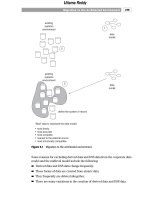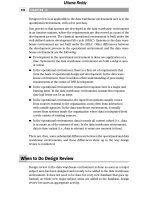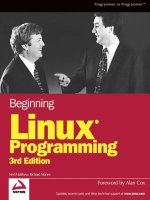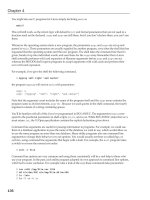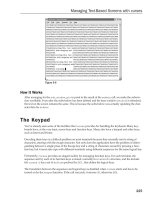Beginning Linux Programming Third Edition phần 1 ppsx
Bạn đang xem bản rút gọn của tài liệu. Xem và tải ngay bản đầy đủ của tài liệu tại đây (1.24 MB, 89 trang )
Beginning Linux®Programming
Third Edition
Neil Matthew
Richard Stones
a544977 FM.qxd 12/1/03 8:55 AM Page i
a544977 FM.qxd 12/1/03 8:55 AM Page iv
Beginning Linux®Programming
Third Edition
Neil Matthew
Richard Stones
a544977 FM.qxd 12/1/03 8:55 AM Page i
Beginning Linux
®
Programming
Third Edition
Published by
Wiley Publishing, Inc.
10475 Crosspoint Boulevard
Indianapolis, IN 46256
Copyright © 2004 by Wiley Publishing, Inc. All rights reserved.
Published simultaneously in Canada
No part of this publication may be reproduced, stored in a retrieval system, or transmitted in any form
or by any means, electronic, mechanical, photocopying, recording, scanning, or otherwise, except as
permitted under Section 107 or 108 of the 1976 United States Copyright Act, without either the prior
written permission of the Publisher, or authorization through payment of the appropriate per-copy fee
to the Copyright Clearance Center, Inc., 222 Rosewood Drive, Danvers, MA 01923, (978) 750-8400, fax
(978) 646-8600. Requests to the Publisher for permission should be addressed to the Legal Department,
Wiley Publishing, Inc., 10475 Crosspoint Blvd., Indianapolis, IN 46256, (317) 572-3447, fax (317)
572-4447, E-mail:
LIMIT OF LIABILITY/DISCLAIMER OF W
ARRANTY: WHILE THE PUBLISHER AND AUTHOR
HAVE USED THEIR BEST EFFORTS IN PREPARING THIS BOOK, THEY MAKE NO REPRESENTA-
TIONS OR WARRANTIES WITH RESPECT TO THE ACCURACY OR COMPLETENESS OF THE
CONTENTS OF THIS BOOK AND SPECIFICALLY DISCLAIM ANY IMPLIED WARRANTIES OF
MERCHANTABILITY OR FITNESS FOR A PARTICULAR PURPOSE. NO WARRANTY MAY BE
CREATED OR EXTENDED BY SALES REPRESENTATIVES OR WRITTEN SALES MATERIALS.
THE ADVICE AND STRATEGIES CONTAINED HEREIN MAY NOT BE SUITABLE FOR YOUR SIT-
UATION. YOU SHOULD CONSULT WITH A PROFESSIONAL WHERE APPROPRIATE. NEITHER
THE PUBLISHER NOR AUTHOR SHALL BE LIABLE FOR ANY LOSS OF PROFIT OR ANY OTHER
COMMERCIAL DAMAGES, INCLUDING BUT NOT LIMITED TO SPECIAL, INCIDENTAL, CON-
SEQUENTIAL, OR OTHER DAMAGES.
For general information on our other products and services please contact our Customer Care Depart-
ment within the United States at (800) 762-2974, outside the United States at (317) 572-3993 or fax (317)
572-4002.
Trademarks: Wiley, Wrox, the Wrox logo, and related trade dress are trademarks or registered trade-
marks of John Wiley & Sons, Inc. and/or its affiliates in the United States and other countries, and may
not be used without written permission. Linux is a trademark of Linus Torvalds. All other trademarks
are the property of their respective owners. Wiley Publishing, Inc., is not associated with any product or
vendor mentioned in this book.
Wiley also publishes its books in a variety of electronic formats. Some content that appears in print
may not be available in electronic books.
Library of Congress Control Number: 2003115911
ISBN: 0-7645-4497-7
Printed in the United States of America
10987654321
3B/RX/RS/QT/IN
a544977 FM.qxd 12/1/03 8:55 AM Page ii
About Neil Matthew
Neil Matthew has been interested in and has programmed computers since 1974. A mathematics graduate
from the University of Nottingham, Neil is just plain keen on programming languages and likes to explore
new ways of solving computing problems. He’s written systems to program in BCPL, FP (Functional
Programming), Lisp, Prolog, and a structured BASIC. He even wrote a 6502 microprocessor emulator to
run BBC microcomputer programs on UNIX systems.
In terms of UNIX experience, Neil has used almost every flavor since the late 1970s, including BSD
UNIX, AT&T System V, Sun Solaris, IBM AIX, many others, and of course Linux.
Neil can claim to have been using Linux since August 1993 when he acquired a floppy disk distribution
of Soft Landing (SLS) from Canada, with kernel version 0.99.11. He’s used Linux-based computers for
hacking C, C++, Icon, Prolog, Tcl, and Java at home and at work.
Most of Neil’s “home” projects were originally developed using SCO UNIX, but they’ve all ported to
Linux with little or no trouble. He says Linux is much easier because it supports quite a lot of features
from other systems, so that both BSD- and System V–targeted programs will generally compile with
little or no change.
As the head of software and principal engineer at Camtec Electronics in the 1980s, Neil programmed
in C and C++ for real-time embedded systems. Since then he’s worked on software development tech-
niques and quality assurance. After a spell as a consultant with Scientific Generics he is currently work-
ing as a systems architect with Celesio AG.
Neil is married to Christine and has two children, Alexandra and Adrian. He lives in a converted barn in
Northamptonshire, England. His interests include solving puzzles by computer, music, science fiction,
squash, mountain biking, and not doing it yourself.
About Rick Stones
Rick started programming at school, more years ago than he cares to remember, on a 6502-powered BBC
micro, which with the help of a few spare parts continued to function for the next 15 years. He graduated
from Nottingham University with a degree in Electronic Engineering, but decided software was more fun.
Over the years he has worked for a variety of companies, from the very small with just a dozen employ-
ees, to the very large, including the IT services giant EDS. Along the way he has worked on a range of
projects, from real-time communications to accounting systems, very large help desk systems, and more
recently as the technical authority on a large EPoS and retail central systems program.
A bit of a programming linguist, he has programmed in various assemblers, a rather neat proprietary
telecommunications language called SL-1, some FORTRAN, Pascal, Perl, SQL, and smidgeons of Python
and C++, as well as C. (Under duress he even admits that he was once reasonably proficient in Visual
Basic, but tries not to advertise this aberration.)
Rick lives in a village in Leicestershire, England, with his wife Ann, children Jennifer and Andrew, and
two cats. Outside work his main interest is classical music, especially early religious music, and he even
does his best to find time for some piano practice. He is currently trying to learn to speak German.
a544977 FM.qxd 12/1/03 8:55 AM Page iii
a544977 FM.qxd 12/1/03 8:55 AM Page iv
Credits
Authors
Neil Matthew
Richard Stones
Executive Editor
Debra Williams Cauley
Development Editor
James H. Russell
Production Editor
Pamela Hanley
Technical Editors
Arthur Griffith
Tobias DiPasquale
Copy Editor
Publication Services
Senior Production Manager
Fred Bernardi
Editorial Manager
Mary Beth Wakefield
Vice President & Executive Group Publisher
Richard Swadley
Vice President and Executive Publisher
Bob Ipsen
Vice President and Publisher
Joseph B. Wikert
Executive Editorial Director
Mary Bednarek
Project Coordinators
Regina Snyder
April Farling
Graphics and Production Specialists
Steved Arany
Beth Brooks
Carrie Foster
Lauren Goddard
Kristin McMullan
Janet Seib
Quality Control Technicians
Laura Albert
Andy Hollandbeck
Rob Springer
Proofreading and Indexing
TECHBOOKS Production Services
a544977 FM.qxd 12/1/03 8:55 AM Page v
a544977 FM.qxd 12/1/03 8:55 AM Page vi
Contents
Foreword by Alan Cox xxxi
Introduction xxxiii
Chapter 1: Getting Started 1
An Introduction to UNIX, Linux, and GNU 1
What Is UNIX? 1
A Brief History of UNIX 2
UNIX Philosophy 2
What Is Linux? 3
The GNU Project and the Free Software Foundation 3
Linux Distributions 4
Programming Linux 5
Linux Programs 5
The C Compiler 6
Try It Out—Our First Linux C Program 7
Development System Roadmap 8
Applications 8
Header Files 8
Library Files 9
Static Libraries 10
Try It Out—Static Libraries 10
Shared Libraries 12
Getting Help 13
Try It Out—Manual Pages and info 14
Summary 15
Chapter 2: Shell Programming 17
Why Program with a Shell? 18
A Bit of Philosophy 18
What Is a Shell? 19
Pipes and Redirection 21
Redirecting Output 21
Redirecting Input 22
Pipes 23
a544977 FM.qxd 12/1/03 8:55 AM Page vii
viii
Contents
The Shell as a Programming Language 23
Interactive Programs 23
Creating a Script 25
Making a Script Executable 26
Shell Syntax 27
Variables 28
Quoting 28
Try It Out—Variables 29
Environment Variables 29
Parameter Variables 30
Try It Out—Parameter and Environment Variables 31
Conditions 32
The test, or [, Command 32
Control Structures 35
if 35
Try It Out—Using the if Command 35
elif 36
Try It Out—Doing Further Checks with an elif 36
A Problem with Variables 36
for 37
Try It Out—for Loop with Fixed Strings 38
Try It Out—for Loop with Wildcard Expansion 38
while 39
Try It Out—Here We Go Again, Again 40
until 41
case 41
Try It Out—Case I: User Input 42
Try It Out—Case II: Putting Patterns Together 42
Try It Out—Case IIl: Executing Multiple Statements 43
Lists 44
Try It Out—AND Lists 45
Try It Out—OR Lists 46
Statement Blocks 47
Functions 47
Try It Out—A Simple Function 47
Try It Out—Returning a Value 49
Commands 50
break 50
The : Command 51
a544977 FM.qxd 12/1/03 8:55 AM Page viii
ix
Contents
continue 51
The . Command 52
Try It Out—The Dot Command 53
echo 53
eval 54
exec 54
exit n 55
export 55
Try It Out—Exporting Variables 56
expr 56
printf 57
return 58
set 58
shift 59
trap 60
Try It Out—Trapping Signals 60
unset 62
Two More Useful Commands and Regular Expressions 62
Try It Out—find with Tests 64
Try It Out—Basic grep Usage 66
Try It Out—Regular Expressions 68
Command Execution 69
Arithmetic Expansion 70
Parameter Expansion 70
Try It Out—Parameter Processing 72
Here Documents 73
Try It Out—Using Here Documents 73
Try It Out—Another Use for a Here Document 74
Debugging Scripts 75
Going Graphical—The Dialog Utility 76
Try It Out—Using the dialog Utility 78
Try It Out 79
Putting It All Together 80
Requirements 81
Design 81
Try It Out—A CD Application 83
Notes on the Application 90
Summary 90
a544977 FM.qxd 12/1/03 8:55 AM Page ix
x
Contents
Chapter 3: Working with Files 91
Linux File Structure 92
Directories 92
Files and Devices 93
/dev/console 93
/dev/tty 93
/dev/null 94
System Calls and Device Drivers 94
Library Functions 95
Low-Level File Access 96
write 96
read 97
open 98
Initial Permissions 100
umask 100
close 101
ioctl 102
Try It Out—A File Copy Program 102
Other System Calls for Managing Files 104
lseek 104
fstat, stat, and lstat 104
dup and dup2 106
The Standard I/O Library 107
fopen 108
fread 108
fwrite 109
fclose 109
fflush 109
fseek 110
fgetc, getc, and getchar 110
fputc, putc, and putchar 110
fgets and gets 111
Formatted Input and Output 111
printf, fprintf, and sprintf 112
scanf, fscanf, and sscanf 114
Other Stream Functions 116
Try It Out—Another File Copy Program 116
Stream Errors 117
Streams and File Descriptors 118
File and Directory Maintenance 118
chmod 118
chown 119
a544977 FM.qxd 12/1/03 8:55 AM Page x
xi
Contents
unlink, link, and symlink 119
mkdir and rmdir 119
chdir and getcwd 120
Scanning Directories 120
opendir 121
readdir 121
telldir 122
seekdir 122
closedir 122
Try It Out—A Directory-Scanning Program 122
Errors 125
strerror 125
perror 126
The /proc File System 126
Advanced Topics: fcntl and mmap 130
fcntl 130
mmap 131
Try It Out—Using mmap 132
Summary 134
Chapter 4: The Linux Environment 135
Program Arguments 135
Try It Out—Program Arguments 137
getopt 138
Try It Out—getopt 139
getopt_long 140
Environment Variables 142
Try It Out—getenv and putenv 143
Use of Environment Variables 144
The environ Variable 145
Try It Out—environ 145
Time and Date 146
Try It Out—time 146
Try It Out—gmtime 148
Try It Out—ctime 150
Try It Out—strftime and strptime 152
Temporary Files 153
Try It Out—tmpnam and tmpfile 154
User Information 155
Try It Out—User Information 156
Host Information 158
Try It Out—Host Information 159
a544977 FM.qxd 12/1/03 8:55 AM Page xi
xii
Contents
Logging 160
Try It Out—syslog 162
Try It Out—logmask 163
Resources and Limits 164
Try It Out—Resource Limits 167
Summary 169
Chapter 5: Terminals 171
Reading from and Writing to the Terminal 171
Try It Out—Menu Routines in C 172
Canonical versus Non-Canonical Modes 173
Handling Redirected Output 174
Try It Out—Checking for Output Redirection 175
Talking to the Terminal 176
Try It Out—Using /dev/tty 176
The Terminal Driver and the General Terminal Interface 178
Overview 178
Hardware Model 179
The termios Structure 180
Input Modes 181
Output Modes 182
Control Modes 183
Local Modes 183
Special Control Characters 184
Characters 185
The TIME and MIN Values 185
Accessing Terminal Modes from the Shell 186
Setting Terminal Modes from the Command Prompt 187
Terminal Speed 187
Additional Functions 188
Try It Out—A Password Program with termios 189
Try It Out—Reading Each Character 190
Terminal Output 191
Terminal Type 191
Identify Your Terminal Type 192
Using terminfo Capabilities 195
Try It Out—Total Terminal Control 198
Detecting Keystrokes 200
Try It Out—Your Very Own kbhit 200
Virtual Consoles 202
Pseudo Terminals 204
Summary 204
a544977 FM.qxd 12/1/03 8:55 AM Page xii
xiii
Contents
Chapter 6: Managing Text-Based Screens with curses 205
Compiling with curses 206
Concepts 207
Try It Out—A Simple curses Program 208
Initialization and Termination 210
Output to the Screen 210
Reading from the Screen 211
Clearing the Screen 211
Moving the Cursor 212
Character Attributes 212
Try It Out—Moving, Inserting, and Attributes 212
The Keyboard 214
Keyboard Modes 215
Keyboard Input 215
Try It Out—Keyboard Modes and Input 216
Windows 217
The WINDOW Structure 217
Generalized Functions 218
Moving and Updating a Window 218
Try It Out—Multiple Windows 219
Optimizing Screen Refreshes 222
Subwindows 223
Try It Out—Subwindows 223
The Keypad 225
Try It Out—Using the Keypad 226
Color 227
Try It Out—-Colors 229
Redefining Colors 230
Pads 230
Try It Out—Using a Pad 231
The CD Collection Application 233
Try It Out—A New CD Collection Application 233
Try It Out—Looking at main 235
Try It Out—The Menu 236
Try It Out—Database File Manipulation 238
Try It Out—Querying the CD Database 243
Summary 247
Chapter 7: Data Management 249
Managing Memory 249
Simple Memory Allocation 250
Try It Out—Simple Memory Allocation 250
a544977 FM.qxd 12/1/03 8:55 AM Page xiii
xiv
Contents
Allocating Lots of Memory 251
Try It Out—Asking for All Physical Memory 251
Try It Out—Available Memory 252
Abusing Memory 254
Try It Out—Abuse Your Memory 254
The Null Pointer 255
Try It Out—Accessing a Null Pointer 255
Freeing Memory 256
Try It Out—Freeing Memory 257
Other Memory Allocation Functions 257
File Locking 258
Creating Lock Files 258
Try It Out—Creating a Lock File 259
Try It Out—Cooperative Lock Files 260
Locking Regions 262
The F_GETLK Command 263
The F_SETLK Command 264
The F_SETLKW Command 264
Use of read and write with Locking 264
Try It Out—Locking a File with fcntl 265
Try It Out—Testing Locks on a File 267
Competing Locks 270
Try It Out—Competing Locks 270
Other Lock Commands 273
Deadlocks 273
Databases 274
The dbm Database 274
Introduction to dbm 274
Getting dbm 275
Troubleshooting and Reinstalling dbm 275
The dbm Routines 276
dbm Access Functions 277
dbm_open 277
dbm_store 277
dbm_fetch 277
dbm_close 278
Try It Out—A Simple dbm Database 278
Additional dbm Functions 280
dbm_delete 281
dbm_error 281
a544977 FM.qxd 12/1/03 8:55 AM Page xiv
xv
Contents
dbm_clearerr 281
dbm_firstkey and dbm_nextkey 281
Try It Out—Retrieving and Deleting 281
The CD Application 282
Updating the Design 283
The CD Database Application Using dbm 283
Try It Out—cd_data.h 284
Try It Out—app_ui.c 285
Try It Out—cd_access.c 295
Summary 302
Chapter 8: MySQL 303
Installation 304
Precompiled Packages 304
Post-Install Configuration 306
Post-Installation Troubleshooting 310
MySQL Administration 310
Commands 310
myisamchk 311
mysql 311
mysqladmin 312
mysqlbug 313
mysqlimport 314
mysqlshow 314
Creating Users and Giving Them Permissions 314
grant 314
revoke 316
Passwords 316
Creating a Database 317
Data Types 318
Boolean 318
Character 318
Number 318
Temporal 319
Creating a Table 319
Graphical Tools 322
Accessing MySQL Data from C 325
Connection Routines 326
Error Handling 330
a544977 FM.qxd 12/1/03 8:55 AM Page xv
xvi
Contents
Executing SQL Statements 331
SQL Statements That Return No Data 331
Discovering What You Inserted 334
Try It Out 334
Try It Out 335
Statements That Return Data 336
Processing Returned Data 340
Miscellaneous Functions 346
The CD Database Application 347
Creating the Tables 348
Adding Some Data 350
Try It Out 352
Accessing the Application Data from C 353
Interface Definition 353
Test Application Interface 354
Implementing the Interface 355
Summary 363
Chapter 9: Development Tools 365
Problems of Multiple Source Files 365
The make Command and Makefiles 366
The Syntax of Makefiles 366
Options and Parameters to make 367
Dependencies 367
Rules 368
Try It Out—A Simple Makefile 368
Comments in a Makefile 370
Macros in a Makefile 370
Try It Out—A Makefile with Macros 370
Multiple Targets 372
Try It Out—Multiple Targets 372
Built-in Rules 374
Suffix and Pattern Rules 375
Managing Libraries with make 376
Try It Out—Managing a Library 376
Advanced Topic: Makefiles and Subdirectories 378
GNU make and gcc 378
Try It Out—gcc -MM 379
Source Code Control 379
RCS 380
The rcs Command 380
The ci Command 381
a544977 FM.qxd 12/1/03 8:55 AM Page xvi
xvii
Contents
The co Command 381
The rlog Command 382
The rcsdiff Command 383
Identifying Revisions 383
Try It Out—GNU make with RCS 385
The ident Command 385
Try It Out—ident 385
SCCS 386
Comparing RCS and SCCS 386
CVS 386
Using CVS Locally 387
Accessing CVS over a Network 390
gCVS 390
BitKeeper 391
Writing a Manual Page 391
Distributing Software 395
The patch Program 395
Other Distribution Utilities 397
RPM Packages 399
Working with RPM Package Files 400
Installing RPM Packages 400
Building RPM Packages 401
Gathering the Software 401
Creating an RPM Spec File 403
Building an RPM Package with rpmbuild 407
Other Package Formats 410
Development Environments 410
xwpe 410
C-Forge 411
KDevelop 412
Other Environments 414
Summary 415
Chapter 10: Debugging 417
Types of Errors 417
General Debugging Techniques 418
A Program with Bugs 418
Code Inspection 421
Instrumentation 422
Try It Out—Debug Information 423
Debugging without Recompiling 424
Controlled Execution 424
a544977 FM.qxd 12/1/03 8:55 AM Page xvii
xviii
Contents
Debugging with gdb 425
Starting gdb 425
Running a Program 426
Stack Trace 427
Examining Variables 427
Listing the Program 428
Setting Breakpoints 429
Patching with the Debugger 432
Learning More about gdb 433
More Debugging Tools 434
Lint: Removing the Fluff from Your Programs 434
Function Call Tools 436
ctags 436
cxref 436
cflow 437
Execution Profiling with prof/gprof 438
Assertions 439
Try It Out—assert 439
Memory Debugging 440
ElectricFence 441
Try It Out—ElectricFence 441
valgrind 442
Try It Out—valgrind 442
Summary 444
Chapter 11: Processes and Signals 445
What Is a Process? 445
Process Structure 446
The Process Table 447
Viewing Processes 447
System Processes 449
Process Scheduling 450
Starting New Processes 451
Try It Out—system 452
Replacing a Process Image 453
Try It Out—execlp 454
Duplicating a Process Image 455
Try It Out—fork 457
Waiting for a Process 458
Try It Out—wait 458
Zombie Processes 460
Try It Out—Zombies 460
a544977 FM.qxd 12/1/03 8:55 AM Page xviii
xix
Contents
Input and Output Redirection 462
Try It Out—Redirection 462
Threads 463
Signals 463
Try It Out—Signal Handling 465
Sending Signals 467
Try It Out—An Alarm Clock 468
A Robust Signals Interface 470
Try It Out—sigaction 470
Signal Sets 471
sigaction Flags 473
Common Signal Reference 474
Summary 476
Chapter 12: POSIX Threads 477
What Is a Thread? 477
Advantages and Drawbacks of Threads 478
A First Threads Program 479
Try It Out—A Simple Threaded Program 481
Simultaneous Execution 483
Try It Out—Simultaneous Execution of Two Threads 483
Synchronization 485
Synchronization with Semaphores 485
Try It Out—A Thread Semaphore 486
Synchronization with Mutexes 490
Try It Out—A Thread Mutex 490
Thread Attributes 494
Try It Out—Setting the Detached State Attribute 495
Thread Attributes—Scheduling 497
Try It Out—Scheduling 497
Canceling a Thread 498
Try It Out—Canceling a Thread 499
Threads in Abundance 501
Try It Out—Many Threads 501
Summary 504
Chapter 13: Inter-Process Communication: Pipes 505
What Is a Pipe? 505
Process Pipes 506
popen 506
pclose 507
Try It Out—Reading Output from an External Program 507
a544977 FM.qxd 12/1/03 8:55 AM Page xix
xx
Contents
Sending Output to popen 508
Try It Out—Sending Output to an External Program 508
Passing More Data 509
Try It Out—Reading Larger Amounts of Data from a Pipe 509
How popen Is Implemented 510
Try It Out—popen Starts a Shell 510
The Pipe Call 511
Try It Out—The pipe Function 512
Try It Out—Pipes across a fork 513
Parent and Child Processes 514
Try It Out—Pipes and exec 515
Reading Closed Pipes 516
Pipes Used as Standard Input and Output 517
File Descriptor Manipulation by close and dup 517
Try It Out—Pipes and dup 518
Named Pipes: FIFOs 520
Try It Out—Creating a Named Pipe 521
Accessing a FIFO 522
Try It Out—Accessing a FIFO File 522
Opening a FIFO with open 523
Try It Out—Opening FIFO Files 524
O_RDONLY and O_WRONLY with No O_NONBLOCK 525
O_RDONLY with O_NONBLOCK and O_WRONLY 526
Reading and Writing FIFOs 526
Try It Out—Inter-Process Communication with FIFOs 527
Advanced Topic: Client/Server Using FIFOs 529
Try It Out—An Example Client/Server Application 530
The CD Database Application 533
Aims 534
Implementation 534
Try It Out—The Header File, cliserv.h 536
Client Interface Functions 538
Try It Out—The Client’s Interpreter 538
Searching the Database 542
Try It Out—Searching 543
The Server Interface 544
Try It Out—server.c 544
The Pipe 548
Try It Out—Pipes Implementation Header 549
Server-Side Functions 549
Try It Out—Server Functions 549
Try It Out—Plumbing the Pipes 551
a544977 FM.qxd 12/1/03 8:55 AM Page xx
xxi
Contents
Client-Side Functions 552
Try It Out—Client Functions 552
Try It Out—Getting Server Results 553
Application Summary 554
Summary 555
Chapter 14: Semaphores, Shared Memory, and Message Queues 557
Semaphores 557
Semaphore Definition 558
A Theoretical Example 559
Linux Semaphore Facilities 560
semget 561
semop 561
semctl 562
Using Semaphores 563
Try It Out—Semaphores 563
Shared Memory 566
shmget 568
shmat 568
shmdt 569
shmctl 569
Try It Out—Shared Memory 570
Message Queues 573
msgget 574
msgsnd 574
msgrcv 575
msgctl 576
Try It Out—Message Queues 576
The CD Database Application 579
Try It Out—Revising the Server Functions 580
Try It Out—Revising the Client Functions 581
IPC Status Commands 583
Semaphores 583
Shared Memory 584
Message Queues 584
Summary 585
Chapter 15: Sockets 587
What Is a Socket? 588
Socket Connections 588
Try It Out—A Simple Local Client 588
Try It Out—A Simple Local Server 590
a544977 FM.qxd 12/1/03 8:55 AM Page xxi
xxii
Contents
Socket Attributes 592
Socket Domains 592
Socket Types 593
Socket Protocols 594
Creating a Socket 594
Socket Addresses 595
Naming a Socket 596
Creating a Socket Queue 596
Accepting Connections 597
Requesting Connections 597
Closing a Socket 598
Socket Communications 598
Try It Out—Network Client 599
Try It Out—Network Server 600
Host and Network Byte Ordering 601
Network Information 602
Try It Out—Network Information 604
Try It Out—Connecting to a Standard Service 606
The Internet Daemon (inetd) 608
Socket Options 609
Multiple Clients 610
Try It Out—A Server for Multiple Clients 610
select 613
Try It Out—select 614
Multiple Clients 616
Try It Out—An Improved Multiple Client/Server 616
Datagrams 619
Summary 622
Chapter 16: Programming GNOME Using GTK+ 623
Introducing X 623
X Server 624
X Client 624
X Protocol 624
Xlib 624
Toolkits 625
Window Managers 625
Other Ways to GUI—Platform-Independent Windowing APIs 625
Introducing GTK+ 626
GLib Type System 626
GTK+ Object System 627
a544977 FM.qxd 12/1/03 8:55 AM Page xxii



